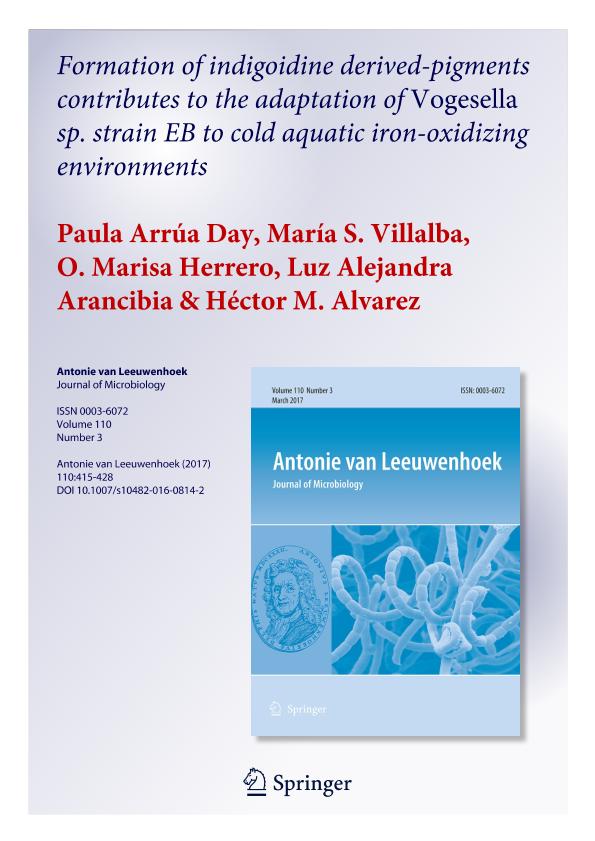Mostrar el registro sencillo del ítem
dc.contributor.author
Arrúa Day, Paula

dc.contributor.author
Villalba, María Soledad

dc.contributor.author
Herrero, Ornella Marisa

dc.contributor.author
Arancibia, Luz Alejandra
dc.contributor.author
Alvarez, Hector Manuel

dc.date.available
2018-02-21T21:23:35Z
dc.date.issued
2017-03-03
dc.identifier.citation
Arrúa Day, Paula; Villalba, María Soledad; Herrero, Ornella Marisa; Arancibia, Luz Alejandra; Alvarez, Hector Manuel; Formation of indigoidine derived-pigments contributes to the adaptation of Vogesella sp. strain EB to cold aquatic iron-oxidizing environments; Springer; Antonie van Leeuwenhoek; 110; 3; 3-3-2017; 415-428
dc.identifier.issn
0003-6072
dc.identifier.uri
http://hdl.handle.net/11336/36942
dc.description.abstract
We investigated previously under explored cold aquatic environments of Andean Patagonia, Argentina. Oily sheens similar to an oil spill are frequently observed at the surface of water in creeks and small ponds in these places. Chemical analysis of a water sample revealed the occurrence of high concentrations of iron and the presence of a free insoluble indigoidine-derived pigment. A blue pigment-producing bacterium (strain EB) was isolated from the water sample and identified as Vogesella sp. by molecular analysis. The isolate was able to produce indigoidine and another derived-pigment (here called cryoindigoidine) with strong antifreeze properties. The production of the pigments depended on the cell growth at cold temperatures (below 15 °C), as well as on the attachment of cells to solid surfaces, and iron limitation in the media. The pigments produced by strain EB showed an inhibitory effect on the growth of diverse microorganisms such as Candida albicans, Escherichia coli and Staphylococcus aureus. In addition, pigmented cells were more tolerant to freezing than non-pigmented cells, suggesting a role of cryoindigoidine/indigoidine as a cold-protectant molecule. The possible roles of the pigments in strain EB physiology and its interactions with the iron-rich environment from which the isolate was obtained are discussed. Results of this study suggested an active role of strain EB in the investigated iron-oxidizing ecosystem.
dc.format
application/pdf
dc.language.iso
eng
dc.publisher
Springer

dc.rights
info:eu-repo/semantics/openAccess
dc.rights.uri
https://creativecommons.org/licenses/by-nc-sa/2.5/ar/
dc.subject
Aquatic Environments
dc.subject
Cold Temperatures
dc.subject
Cryoindigoidine
dc.subject
Vogesella
dc.subject.classification
Otras Ciencias Biológicas

dc.subject.classification
Ciencias Biológicas

dc.subject.classification
CIENCIAS NATURALES Y EXACTAS

dc.title
Formation of indigoidine derived-pigments contributes to the adaptation of Vogesella sp. strain EB to cold aquatic iron-oxidizing environments
dc.type
info:eu-repo/semantics/article
dc.type
info:ar-repo/semantics/artículo
dc.type
info:eu-repo/semantics/publishedVersion
dc.date.updated
2018-02-20T17:07:03Z
dc.identifier.eissn
1572-9699
dc.journal.volume
110
dc.journal.number
3
dc.journal.pagination
415-428
dc.journal.pais
Alemania

dc.journal.ciudad
Berlin
dc.description.fil
Fil: Arrúa Day, Paula. Universidad Nacional de la Patagonia ; Argentina
dc.description.fil
Fil: Villalba, María Soledad. Universidad Nacional de la Patagonia ; Argentina. Oil M&S; Argentina
dc.description.fil
Fil: Herrero, Ornella Marisa. Oil M&S; Argentina. Universidad Nacional de la Patagonia ; Argentina
dc.description.fil
Fil: Arancibia, Luz Alejandra. Universidad Nacional de la Patagonia; Argentina
dc.description.fil
Fil: Alvarez, Hector Manuel. Universidad Nacional de la Patagonia ; Argentina
dc.journal.title
Antonie van Leeuwenhoek

dc.relation.alternativeid
info:eu-repo/semantics/altIdentifier/doi/https://doi.org/10.1007/s10482-016-0814-2
dc.relation.alternativeid
info:eu-repo/semantics/altIdentifier/url/https://link.springer.com/article/10.1007%2Fs10482-016-0814-2
Archivos asociados
